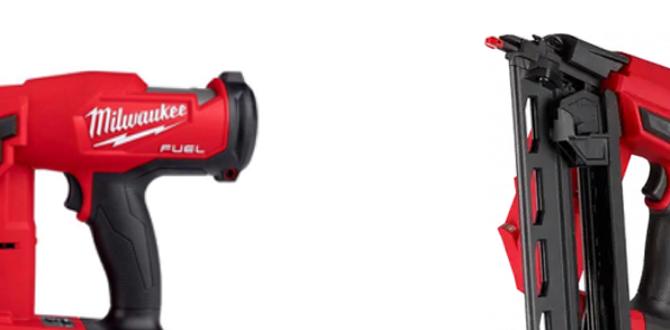Quick Summary:
Mastering a framing nailer is straightforward with the right guidance. This guide breaks down safe operation, nail selection, and expert tips for confidently tackling any framing project, from walls to floors, ensuring strong, durable results the first time.
Hey there, DIY enthusiasts and aspiring woodworkers! Jack here from Nailerguy, your go-to source for all things tools and timber. Ever stared at a pile of lumber and a powerful framing nailer, wondering how to bring it all together securely? Maybe you’ve tackled smaller projects, but the thought of wielding this robust tool feels a bit daunting. You’re not alone! Many beginners find framing nailers intimidating, but they’re actually designed to make big jobs easier and faster. With a little knowledge and practice, you can confidently build sturdy structures. This guide is your roadmap to understanding and expertly using a framing nailer, so you can stop worrying and start building. We’ll cover everything from the basics to advanced techniques, ensuring you’re ready for any project.
Table of Contents
Why a Framing Nailer is a DIY Game Changer
Imagine building the frame of a shed, a deck, or even adding an extension to your home. Traditionally, this involved a lot of hammering, sweat, and time. Enter the framing nailer. This tool is designed to drive large nails quickly and efficiently, making structural projects significantly less labor-intensive. For DIYers, it means completing framing tasks in a fraction of the time, and with greater accuracy. This not only saves you physical effort but also ensures a stronger, more robust structure thanks to consistent nail placement.
Whether you’re a seasoned carpenter or just starting out with a home improvement project, understanding how to use a framing nailer safely and effectively is a crucial skill. It opens up possibilities for larger, more ambitious projects that might otherwise seem out of reach. Think of it as unlocking a new level in your DIY capabilities. We’ll demystify the process, making it accessible and even enjoyable.
Understanding Your Framing Nailer: The Basics
Before we fire it up, let’s get acquainted with your tool. Framing nailers are powerful pneumatic (air-powered) or cordless tools designed for one job: driving long nails into tough materials like dimensional lumber. They are not delicate tools; they are built for power and speed in structural applications.
Types of Framing Nailers
While the core function is the same, there are a few variations to consider:
- Pneumatic Framing Nailers: These are the workhorses. They require an air compressor and a hose to operate. They are generally lighter in the hand and offer consistent power. The trade-off is the need for extra equipment (compressor, hose) and the management of the hose itself.
- Cordless Framing Nailers: These offer freedom from hoses and compressors. They typically run on batteries (which power a motor to drive the nail) or use a fuel cell and battery system. They are more convenient for tight spaces or when portability is key. The initial cost can be higher, and battery life is a consideration.
- Hybrid Framing Nailers: Some cordless models can also run off an AC adapter, giving you the best of both worlds.
Key Components
No matter the type, most framing nailers share these parts:
- Nail Magazine: Holds the nails. It’s angled to match the angle of standard framing lumber.
- Nose/Contact Trip: This is the safety feature. You must depress the nose against the surface you’re nailing for the tool to fire.
- Trigger: Fires the nail when depressed and the contact trip is engaged.
- Depth Adjustment Dial: Controls how deep the nail is driven into the wood.
- Air Inlet (for pneumatic): Where the air hose connects.
- Battery/Fuel Cell Compartment (for cordless): Houses the power source.
Safety First: Essential Precautions
As mentioned, framing nailers are potent tools. Safety isn’t just a suggestion; it’s paramount. Treat this tool with respect, and you’ll avoid injuries and ensure successful projects.
Must-Have Safety Gear
Always wear these, no exceptions:
- Safety Glasses: Non-negotiable. Wood chips and even nails can fly. Use ANSI Z87.1 compliant glasses.
- Hearing Protection: Nail guns are loud. Earplugs or earmuffs are essential for protecting your hearing.
- Work Gloves: Protect your hands from splinters and provide a better grip on the tool.
- Sturdy Footwear: Protect your feet from falling materials or accidental drops of the nailer.
Safe Operating Practices
Follow these rules diligently:
- Read the Manual: Every tool is slightly different. Understand your specific model’s operation and safety features.
- Never Bypass Safety Features: The nose piece (contact trip) is there for a reason. Don’t tamper with it.
- Keep Fingers Away from the Trigger and Nose: Treat the nailer with respect. Don’t point it at yourself or others, even when not powered.
- Secure Your Workpiece: Ensure the material you’re nailing is stable.
- Maintain a Stable Stance: Good balance prevents slips and accidents.
- Never Carry the Nailer by the Hose or Cord: Always support the tool securely.
- Disconnect Power When Not in Use: For pneumatic nailers, disconnect the air hose. For cordless, remove the battery.
- Be Aware of Your Surroundings: Ensure no one is behind the workpiece, as nails can pass through thin materials. Consult resources from OSHA (Occupational Safety and Health Administration) for comprehensive safety guidelines regarding power-actuated tools.
Choosing the Right Nails
Not all nails are created equal, and using the wrong ones can damage your nailer or compromise your project’s integrity. Framing nailers use specific types of nails designed for structural strength.
Nail Size and Type
Framing nails are typically 2 to 3.5 inches long and have a larger diameter than finish nails. They come in different head types:
- Full Round Head: Offers the most holding power and is common in structural framing. Requires a nailer with a steeper magazine angle (usually 21 or 22 degrees).
- Offset Round Head (or D-Head): Features nails that sit side-by-side in the magazine, allowing for a more compact tool and a straighter magazine angle (usually 28 or 30 degrees). They provide good holding power, though slightly less than full round heads.
- E-Head (or Clipped Head): These nails have their heads partially removed to allow them to be placed closer together in the magazine. While they hold many nails, they offer less shear strength and are generally not recommended for critical structural applications due to code restrictions in some areas. Always check local building codes. For example, the International Residential Code (IRC) has specific requirements for nail head types in structural framing.
Nail Material and Finish
Nails can be made of various metals and have different coatings:
- Galvanized Nails: Coated with zinc, these are essential for exterior projects or framing that will be exposed to moisture. They resist rust.
- Stainless Steel Nails: Offer superior corrosion resistance, ideal for very harsh or coastal environments.
- Bright/Common Nails: Uncoated nails, suitable only for interior applications where moisture is not a concern.
Always ensure the nails you buy are specifically designed for framing nailers and match the angle of your nailer’s magazine. Your nailer manual will specify the type and size of nails it accepts.
Step-by-Step Guide: How to Use Your Framing Nailer
Now for the fun part! Let’s walk through the process of using your framing nailer for a project. We’ll assume you’re using a pneumatic nailer for this example, but the principles apply to cordless models as well.
Step 1: Prepare Your Workspace and Nailer
Before you even pick up the nailer:
- Ensure you are wearing all your safety gear.
- Clear the area of any obstructions or debris.
- If using a pneumatic nailer, connect your air hose to the compressor and the nailer. Ensure the compressor is turned off before connecting.
- Set up your air compressor to the recommended PSI (pounds per square inch) for your nailer. Check your nailer’s manual; typically, this is between 70-120 PSI. Too low and nails won’t drive; too high and you risk damaging the tool or workpiece.
Step 2: Load the Nails
This is a critical step:
- Ensure the nailer is disconnected from the air source (for pneumatic) or the battery is removed (for cordless).
- Slide the nails into the magazine. Most magazines have a spring-loaded pusher. Pull the pusher back, place the nails in the slot, and release the pusher to hold the nails firmly in place.
- Make sure the nails are oriented correctly to match your magazine’s angle. The heads should be facing the direction indicated by the tool’s design.
- Ensure you are using the correct size and type of nails for your specific nailer and project.
Step 3: Set the Depth Adjustment
This setting determines how deep the nail penetrates the wood.
- Locate the depth adjustment dial, usually near the nose of the gun.
- For softwood (like pine or fir): You’ll likely need to set the depth shallower.
- For hardwood or to ensure nails are fully countersunk: Set the depth deeper.
- Test on Scrap Wood: It’s crucial to test the depth setting on a piece of scrap lumber identical to your project material. Drive a nail and check its depth. Adjust the dial and test again until you achieve the desired result – a nail that is flush or slightly countersunk. Never try to adjust depth on the fly during a critical project.
Step 4: Choose Your Firing Mode (If Applicable)
Many framing nailers have two firing modes:
- Sequential Mode (Bump Fire): This is the most common for framing. You place the nose on the wood, squeeze the trigger and hold it down, then “bump” the nose against the workpiece to drive nails. This allows for rapid nail placement.
- Contact Trip Mode (Full Sequential): Where you must first press the nose onto the work surface, then pull the trigger to fire one nail. Release the trigger and contact trip, then repeat. This offers more control but is slower.
For most framing tasks, sequential firing (holding down the trigger and bumping the nose) is preferred for speed. Always ensure you understand which mode your nailer is in and how to switch between them.
Step 5: Start Nailing!
This is where skill and practice come in.
- Position the Nailer: Place the nose of the nailer firmly against the surface where you want to drive a nail. Ensure the contact trip is fully depressed.
- Fire the Nail: If in sequential mode, hold the trigger down. If in contact trip mode, pull the trigger.
- Drive the Nail: For sequential mode, once the trigger is held, briefly press the nose onto the workpiece. The nail should fire.
- Move to the Next Spot: Quickly lift the nose, reposition, and repeat.
- Accuracy is Key: Aim to drive nails straight and at the correct spacing as dictated by your building plans or codes. Avoid nailing too close to the edge of the wood, which can cause splitting.
Step 6: How to Use Framing Nailer on Floor Joists (Specific Application)
Framing floor joists is a common and critical application for a framing nailer. Here’s how to approach it:
- Understand the Connection: Floor joists are typically attached to a rim joist or ledger board. The goal is to secure the end of each joist with multiple nails driven through the rim joist/ledger and into the end grain of the joist.
- Nail Placement: For a standard 2x joist connected to a rim joist, you’ll typically drive nails in a staggered pattern. This means driving a few nails from the outside of the rim joist into the joist, then a few more nails from a slightly different angle to ensure maximum holding power.
- Angle of Nails: When framing joists, you’re often nailing long-grain to long-grain, or more commonly, through the rim joist into the end grain of the joist. The angle of your nailer relative to the joist matters. Aim for nails to go as deep into the joist as possible without overdriving or missing.
- Number of Nails: Always follow your building plans or local codes for the number of nails required. A common practice is to use 3-4 nails per joist connection.
- Driving Nails: Position your nailer so the nose is flush against the rim joist, and the nail will enter the joist at the desired point. Use sequential firing (hold trigger, bump nose) for speed. Ensure you’re not too close to the end of the rim joist to avoid splitting.
- Example: Nailing a 2×8 Floor Joist to a Rim Joist:
- Connect your nailer and set PSI and depth.
- Take your framing nailer and place it against the rim joist, aligning the nail where it will enter the end of the 2×8 joist about 1 inch up.
- Hold the trigger down and bump the nose to drive the first nail.
- Move up slightly (about 1.5 inches) and drive the second nail.
- Repeat for a third or even fourth nail, staggering them within the joist.
- You might also drive through the other side of the rim joist into the joist depending on the framing method.
Remember to check the structural integrity of your connections. If a nail doesn’t drive fully, don’t force it too many times; adjust depth or check for obstructions. For critical structural connections, consult professional building guides or local building codes, such as those provided by the International Code Council (ICC).
Step 7: Finishing Up and Maintenance
Once your project is framed:
- Release the trigger and disconnect the power source (air hose or battery).
- If you have a pneumatic nailer, drain any excess air from the hose by pulling the trigger while disconnected.
- Check for any jammed nails. Consult your manual for clearing procedures. Do this with the nailer disconnected from power.
- Store your nailer and accessories in a clean, dry place.
- Regular maintenance, such as occasional oiling (for pneumatic tools) and keeping the tool clean, will extend its lifespan and ensure reliable performance.
Troubleshooting Common Framing Nailer Issues
Even with the best practices, you might encounter hiccups. Here are a few common problems and their solutions:
| Problem | Possible Cause(s) | Solution |
|---|---|---|
| Nail doesn’t drive fully | – Incorrect air pressure (too low) – Depth adjustment too shallow – Wrong nail size/type – Jams or obstructions in the tool |
– Increase air pressure to recommended PSI. – Adjust depth deeper. – Verify nail collation and size. – Clear any nail jams. |
| Nail drives too deep (countersunk excessively) | – Incorrect air pressure (too high) – Depth adjustment too deep |
– Decrease air pressure. – Adjust depth shallower. |
| Tool fires inconsistently | – Low air pressure – Internal tool issue – Battery low (cordless) |
– Check and adjust air pressure. – Inspect for dirt or damage; seek professional repair if needed. – Recharge or replace battery. |
| Nail jams in the magazine | – Bent or damaged nails – Incorrect nail collation – Tool dropped or impacted |
– Remove and inspect all nails; replace damaged ones. – Ensure nails are loaded correctly end-to-end. – Carefully clear jam following manual instructions. |
| Air leaking from the tool | – Loose air fitting (pneumatic) – Damaged O-rings or seals – Uneven contact trip |
– Tighten fittings. – Inspect and replace worn seals (may require professional service). – Ensure nose/contact trip moves freely. |
Tips for Efficient and Professional Framing
Beyond the basic operation,


